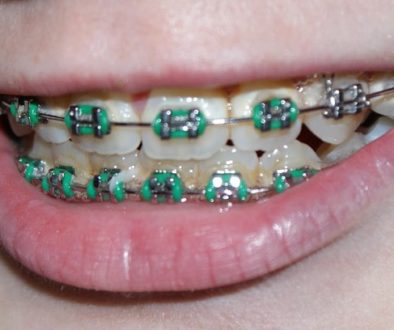Abfraction
 Abfraction is a dental term for wedge shaped areas that sometimes form along the gumline of teeth over time, not related to cavities. It’s an extremely common occurence, especially in older patients, although I have seen it in young adults as well. Abfractions range from very minimal loss of tooth structure to very significant wedges that span nearly 1/3 the width of the tooth. I’ve seen some abfractions that extend nearly all the way into the nerve of the tooth, with just a thin layer of tooth structure covering the nerve. The picture shows a pretty advanced case with wear nearly into the space where the nerve is.
Abfraction is a dental term for wedge shaped areas that sometimes form along the gumline of teeth over time, not related to cavities. It’s an extremely common occurence, especially in older patients, although I have seen it in young adults as well. Abfractions range from very minimal loss of tooth structure to very significant wedges that span nearly 1/3 the width of the tooth. I’ve seen some abfractions that extend nearly all the way into the nerve of the tooth, with just a thin layer of tooth structure covering the nerve. The picture shows a pretty advanced case with wear nearly into the space where the nerve is.
If you’re starting to notice areas like these along your teeth, you’re probably wondering why does it happen and what can you do to prevent it from progressing any further.
What causes abfractions?
The term abfraction has only been around since 1991. Abfractions have been around much longer than that but weren’t recognized specifically until then. As a result, not a whole lot of definitive research has been done to determine what exactly causes them to form. There are basically two schools of thought about their causes and the truth is likely that a combination of both forces as well as some other minor factors play into it.
The first factor is thought to be excessive force on the teeth from a “bad bite” or grinding. The abfractions form specifically in the area where the tooth is thought to move and flex. The theory is that all this pressure causes the tooth to flex so much that the tooth surface in that area starts to break down.
The second factor is thought to be excessive wear from toothbrushing. Hard toothbrushes, too much pressure, and highly abrasive toothpastes can all contribute to this. I saw one experiment where they took actual teeth (not in people’s mouths of course) and used a machine to aggressively brush them with abrasive toothpaste. Over time these teeth developed areas that looked exactly the same as abfractions do in the mouth.
It’s also thought that acid erosion in the mouth could cause this process to progress more rapidly.
My experience with patients over the years backs up the thought that there a lot of different factors at play. I’ve seen people who don’t have any wear from grinding at all but have developed significant abfractions. I’ve seen patients who do grind severely but don’t have any abfractions. I’ve seen patients who from all appearances, never brush their teeth, and definitely not with toothpaste, but still develop large abfractions. There isn’t one single factor that seems to tie them all together.
How can you prevent abfractions?
As we just discussed, we’re still not entirely sure what combination of factors causes abfractions to form. Your specific situation may lean more towards an abrasive process while for someone else it may be more related to excessive force on the teeth. It’s usually best to try and address both of these factors regardless.
- Reducing abrasive forces on the teeth
- Stay away from abrasive toothpastes. The biggest offenders are toothpastes that market themselves as having a whitening effect.
- Use a soft toothbrush. An electric toothbrush is even better. See our recommendations here.
- Brush gently, especially along the gumline.
- Don’t brush right after exposure to acidic foods or drinks… your enamel is temporarily weaker and needs about 30 minutes to remineralize before brushing
- Reducing excessive force on the teeth
- Wear a nightguard. This distributes and dissipates the force from grinding.
- Make sure you wear it every night.
- You can either have your dentist make one, order one from an online dental lab, or use our premium guide to fabricate a custom one at home.
- Reduce acid erosion of your teeth
- Avoid consistent exposure to acidic drinks, especially all types of soda
- Treat heartburn
- Don’t suck on lemons, limes, or sour candy
Is there any treatment for abfractions that have already developed?
If abfractions cause a tooth to become sensitive or pose a cosmetic problem you can have your dentist place a white composite filling to replace the missing tooth structure. Because the tooth surface is very smooth and often non-retentive, it can be more challenging to keep these fillings from coming out, especially if the forces that caused the abfraction are still present. These same forces will tend to break the bond of the filling material to the tooth surface over time.



